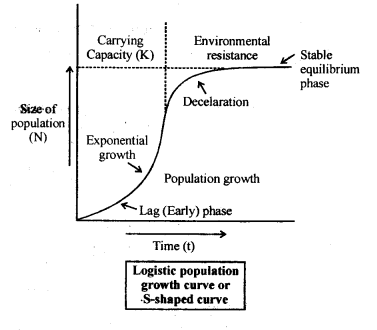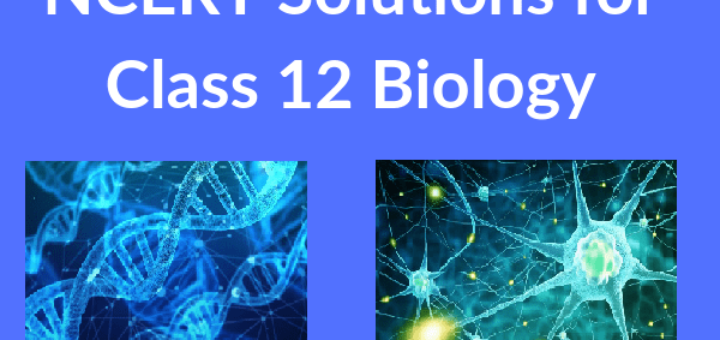Topics and Subtopics in NCERT Solutions for Class 12 Biology Chapter 13 Organisms and Populations:
| Section Name | Topic Name |
| 13 | ORGANISMS AND POPULATIONS |
| 13.1 | Organism and Its Environment |
| 13.2 | Populations |
| 13.3 | Summary |
QUESTIONS FROM TEXTBOOK SOLVED
1. How is diapause different from hibernation?
Ans. Diapause is a period of suspended growth or development occurring in many insects and other invertebrates during which metabolic activities are greatly reduced. On the other hand, hibernation is a sleep like state in which a few animals, such as fishes and amphibians, pass the winter season as a way of surviving food scarcity and cold weather.
2. If a marine fish is placed in a fresh water aquarium, will the fish be able to survive? Why or why not?
Ans. When a marine fish is placed in a fresh water aquarium, the fish will not be able to survive because marine fish is adapted to live in saline seawater. In fresh water, it will not be able to cope with the outside hypotonic environment because of osmoregulation problem. In fresh water, the concentration of water, the difference between the concentration of the water and inside of the fish are increased and therefore, the osmotic pressure is also increased.The fish has to take more water into the body to be able to survive and to get rid of the excess salt present in its body.
3. Define phenotypic adaptation. Give one example.
Ans. Phenotypic adaptations are non-genetic changes
occurring in living organisms due to various extreme environmental conditions, such as stress, extreme temperature, change of habitat. These includes acclimatization, behavioural changes, etc.
4.Most living organisms cannot survive at temperature above 45°C. How are some microbes able to live in habitats with temperatures exceeding 100°C?
Ans. Micro-organisms of hot.springs and vents (mouth of sea bed volcanoes) are able to survive at the high temperature due to
(i)occurrence of branched chain lipids in their cell membrane that reduce fluidity of cell membranes.
(ii)having minimum amount of free water in their bodies. Removal of water provides resistance to high temperature.
5. Last the attributes that populations but not individuals possess.
Ans. Some significant attributes that populations but not individual possess are –
(i)Natality
(ii)Mortality
(iii)Growth forms
(iv)Population density
(v)Population dispersion
(vi)Population age distribution
(vii)Sex ratio
6.If a population growing exponentially double in size in 3 years, what is the intrinsic rate of increase (r) of the population?
Ans. If the population growing exponentially double in size in 3 years, the intrinsic rate of increase of this population will be towards maximum.
7. Name important defence mechanisms in plants against herbivory.
Ans. There are various defence measures for animals against predators. But plants, as they cannot move away, have certain defence mechanisms against herbivory. Their main defences are chemical toxins, such as strychnine, a poison produced by tropical vine, morphine by opium poppy, nicotine produced by tobacco plant. Apart from these chemicals, the common defence measure is presence of spines (modified leaves) on the leaves, stems of the plant, modifications of leaves into thorns, development of sharp silicated edges in leaves which prevent them against damage caused by herbivores.
8.An orchid plant is growing on the branch of mango tree. How do you describe this interaction between the orchid and the mango tree?
Ans. An orchid plant is growing on the branch of a mango tree is called epiphyte, i.e., plants growing on other plants or trees. This type of interaction is known as commensalism, where in orchid / derives benefit of interaction whereas mango tree is not affected. The orchid growing on the branch of mango tree get more light to grow and also, the mango is not harmed in any way.
Commensalism can be defined as an interaction between two animal or plant species that habitually live together in which one species benefits from the association while the other is not significantly affected.
9. What is the ecological principle behind the biological control method of managing with pest insects?
Ans. The ecological principle behind the biological control method of managing with pest insects is predator – prey relationship. It is based on the ability of the predator to regulate prey population.
10.Distinguish between the following:
(a)Hibernation and Aestivation
(b) Ectotherms and Endotherms
Ans.
11.Write a short note on
(a)Adaptations of desert plants and animals
(b)Adaptations of plants to water scarcity
(c)Behavioural adaptations in animals
(d)Importance of light to plants
(e)Effect of temperature or water scarcity and the adaptations of animals.
Ans. (a) Desert plants have very small leaves or no leaves at all, and carrying out photosynthesis through the stems. Their stem could become succulent, and can store and retain water. Animals living in hot climatic region tend to be smaller than those living in cold climates. This can be explained by the fact that the amount of heat gained from the environment is approximately proportional to the body surface area. The majority of animals living in desert are small, like kangaroo rat. It feed on dry seeds and other dry plant material and does not drink,
(b)The evergreen trees such as Rhododendron, show water scarcity by an inward curling of the leaves. A more significant response is the closure of stomata, which reduces transpiration, but raises the internal temperature of die leaf affecting the rate of synthesis of proteins and photosynthesis. Deciduous trees of the temperature region drop their leaves in autumn, avoiding winter drought. Some water stressed plant’s accumulate excessive amounts of inorganic ions.
(c)Migrating temporarily to a less stressful habitat forms a more stressful habitat is a kind of behavioural adaptation in animals which enables them to survive in better environmental conditions. Desert lizards regulate their body temperature constant by behavioural means. They bask in the sun and absorb heat when their body temperature decreases below the optimum, but move into shady or underground places when the temperature of the surrounding area starts increasing.
(d)Light affects plants through its quality, intensity and duration. Duration of light affects phenology, photosynthesis, growth, reproduction, flowering. Quality of light influences flowering, seed germination and movements. Light is required for the production of chlorophyll in chloroplasts. Plants germinated under insufficient illumination causes the destruction of chlorophyll.
(e)Animals mainly are of two types as they are adapted to controlling their body temperature. Poikilothermous are the animals whose temperature fluctuates with that of the environment, e.g., invertebrates and vertebrates, other than birds and animals. In contrast, homeotherms are the animals which can maintain their body temperature at a constant level, e.g., birds and mammals.
12.List the various abiotic environmental factors.
Ans. The various abiotic environmental factors are
Temperature, light, water, wind, humidity, precipitation, altitude, soil type, soil pH, soil aeration, hydration, minerals (edaphic factors).
13.Give an example for:
(a)An endothermic animal
(b)An ectothermic animal
(c)An organism of benthic zone
Ans.(a) Man, (Homo sapiens)
(b)Black bear
(c)Corals
14.Define population and community.
Ans. Population can be defined as the total number of individuals of a species or any other class of an organism in a defined area or habitat or a group of individuals of the same species within a commnity.
Community can be defined as a naturally octurring assemblage of species living within a defined area or habitat.
15.Define the following terms and give one example for each:
(a)Commensalism (b)Parasitism
(c)Camouflage (d)Mutualism
(e)Interspecific competition
Ans. (a)Commensalism is the association between organisms of different species in which one species benefits but does not apparent harm to the other. For example, in the large intestine of human being, bacteria Escherichia coli are present which helps in digestion.
(b)Parasitism is an association in which one organism lives on or in the body of another, from which it obtains its food. For example, the parasites of humans include fleas and lice, various bacteria, protozoans and fungi.
(c)Camouflage is a high degree of similarity between an animal and its visual environment, which enables it be disguished or concealed. For example, birds with necks and heads of contrasting colours are not easily recognised by their enemies under certain conditions.
(d)Mutualism is an association between two organisms of different species in which each partner benefits. For example, the cross fertilization or pollination of plant flowers by insects (sometimes by birds) is a mutual relation of wide occurrence and great importance, because many plants are self- sterile.
(e)Inter-specific competition can be defined as an interaction occurs between different species that share some environmental resource when this is in short supply. Inter-specific competition often results in the dominance of one species over another. For example, when two species of Paramoecium,Paramoecium caudatum and P.aurelia are confined in a closed containers with fixed amount of food, out of them one species always died out.
16.With the help of suitable diagram describe the . ; logistic population growth curve.
Ans. The S-shaped growth curve is also called a logistic growth curve. It describes a situation in which (in a new environmental condition) the population density of an organism increases slowly establishing itself then increasing rapidly, approaching an exponential growth rate. Many population of micro-organisms broadly follow this basic sigmoidal pattern. For example, when a fresh culture medium is inoculated with bacteria, sigmoidal or S-shaped growth curve is observed. The S-shaped curve is generated when a population approaches the environmental’s carrying capacity. Carrying capacity is the maximum number of individuals of a population that can be supported in a given time.
The S-shaped growth form is represented by the following equation- ” dNldt = rN[K-NIK]
Where, r = intrinsic rate of natural increase N = population density at time t K = carrying capacity
17.Select the statement which explains best parasitism.
(a)One organism is benefited.
(b)Both the organisms are benefited.
(c)One organism is benefited, other is not affected.
(d)One organism is benefited, other is affected.
Ans.(d) One organism is benefited, other is affected.
18.List any three important characteristics of a population and explain.
Ans.The three important characteristics of a population are:
(a)Density:The number of individuals per unit area or volume. For example, the number of frogs per m3 of forest region.
(b)Natality or Birth rate :The birth rate is determined by the number of individuals bom to a given population during a given period of time.
(c)Mortality or Death rate: The death rate or mortality represents a decrease in a given population during a given period of time. Generally, the death of individuals in a population are expressed by specific mortality which is described as the mortality population are expressed by specific mortality which is described as the mortality for given age group.






